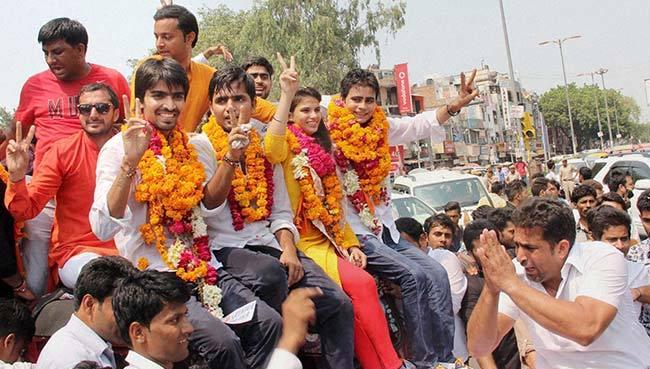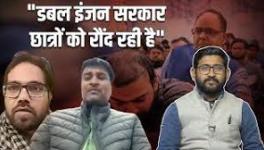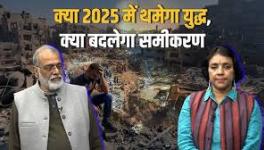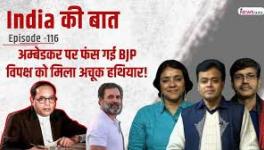In the Bazaar of Democracy: DUSU Elections

Image Courtesy: NDTV
The University of Delhi will go to the polls on 12 September, 2017 to democratically elect a student’s body of representatives to the Delhi University Students’ Union (DUSU). The preparations which lead to this public exercise in representing democracy begin way early in the month of July, when aspiring students swarm the corridors of colleges, seeking admission in what is believed to be a premier University for the study of liberal arts.
In my two years of affiliation to the University, and the subsequent experience of this jamboree of electoral democracy, I have realised how a vicious propaganda of hate, corruption, and patriarchy is peddled in the name of democracy. In these scorching summer months, the University becomes the most unequal space to inhabit, the most unaccommodating construct to comprehend, and perhaps the most regressive social structure to exist in. For those of us who believe in “the personal is political”, for the traditions of collective conscience that this University has witnessed, the annual DUSU elections are anything but democratic, in the true sense of the word.
The campaigning process ushers in a season of post-truth on campus, turning it into a near-apocalyptic paradise of money and muscle power. The Lyngdoh Committee, which was set up by the Ministry of Human Resource Development (MHRD) in 2006 to suggest reforms to students’ union elections in institutions of higher learning, states in its recommendations that “…the entire process of elections, commencing from the date of filing of nomination papers to the date of declaration of results, including the campaign period, should not exceed 10 days” (6.4.1). In practice, the electoral campaign is a protracted process, and the visual imagery is of pomp and splendour, akin to an insecure monarch’s efforts at legitimising his reign. The candidates and their chaperons cruise the campus in Mahindra Boleros and Mercedes, putting up tableaux of purchasing power and consumerism. (The use of loudspeakers, vehicles and animals for the purpose of canvassing shall be prohibite, 6.7.10, Lyngdoh Committee).
This iconography of power is premised on a stark divide between the “representative” and the “represented”, and aims to secure support by subtle ideological coercion. The sheer indifference to the socio-economic diversity of the university, and the failure to comprehend the role of a public-funded institution, underscores the campaigns. How does an 18-year-old coming from a middle class family from a moffusil town in Central India relate to this exhibition of wealth and power? Is it just the spectacle or the magic of something far removed from your existential reality that forms your democratic choice?
“We desire objects only if they are not immediately given to us for our use and enjoyment, that is, to the extent to which they resist our desire,” wrote George Simmel. And this seems to be a plausible explanation for a material extravaganza designed to entice people. Yes, I have seen votes being bought for bottles of Johnnie Walker and Blenders Pride (All candidates shall be prohibited from indulging or abetting, all activities which are considered to be “corrupt practices” and offences, such as bribing of voters, intimidation of voters… 6.7.4, Lyngdoh Committee). Perhaps, in this era of consumerism, democracy is too cheap a price to pay for exotic liquor. In the serpentine lanes of Kamla Nagar and Malkaganj, the democratic conscience is drugged to sleep, turning the lanes into bazaars of democracy, where voters become traders, intoxicated in the transactions of rights. Thus, the vote, which had a sui generis use value, acquires an exchange value, on the pyre of democracy.
“No candidate shall indulge in, nor shall abet, any activity, which may aggravate existing differences or create mutual hatred or cause tension between different castes and communities, religious or linguistic, or between any group(s) of students,” (6.7.1) recommends the Lyngdoh committee. Keeping aside the invocations to ethnic and regional ties, the sights and sounds of the campaigns are palpably majoritarian. And this majority is not the democratic majority, which is heterogeneous and changing, but an unchanging identity based on ascriptive markers.
The most repulsive and unequal aspect of the campaign is its hyper-masculine nature. The invasion of personal space by campaigners is non-consensual, and drastically alters the notion of the University as a safe and agreed-upon public space. The assertive territorial claims made by candidates, both in words and actions, are unconstitutional, and give an impression of some sort of feudal landholding that they might have inherited in patriliny. Pinjra Tod, in its mass protests, reiterates that the University belongs to all its students, it is not a fief of the men (“Ye university humari hai, purusho ki jaagir nahi”). But the annual elections fail to take this into account- it takes pride in being patriarchal. Looking beyond the general pattern and keeping aside my cynicism, a balanced representation of women, and gender-equal agendas were seen in the manifesto of a party, but the larger pattern of practices is rooted in male chauvinism.
The Lyngdoh Committee strictly warns the candidates against destruction and vandalism on campus. A walk down the Chhatra Marg (North Campus) is sufficient to realise how defiantly and unconstitutionally the campaigning takes place in the University of Delhi. Walls, bus stands, the metro station, facades of shops and other public works are defaced with the names of the candidates. Posters spewing venom against co-contestants and images of violence and hate abound the campus. As the streets lay littered with pamphlets and posters, the candidates march to mould their political careers, adding to the global crisis, one carbon footprint per step.
Disclaimer: The views expressed here are the author's personal views, and do not necessarily represent the views of Newsclick.
Get the latest reports & analysis with people's perspective on Protests, movements & deep analytical videos, discussions of the current affairs in your Telegram app. Subscribe to NewsClick's Telegram channel & get Real-Time updates on stories, as they get published on our website.














